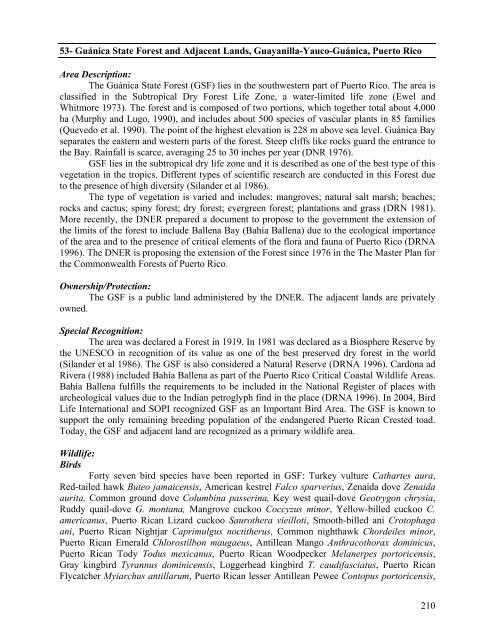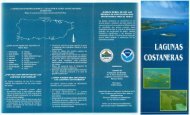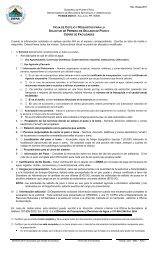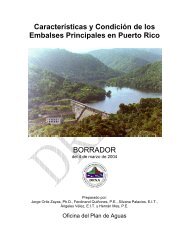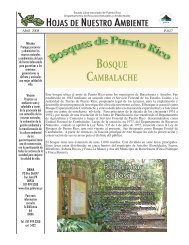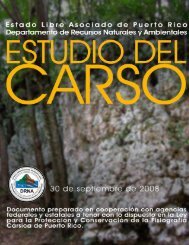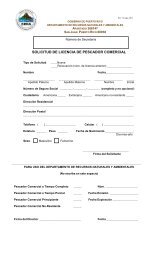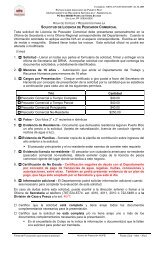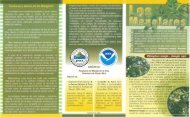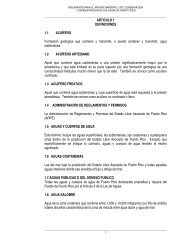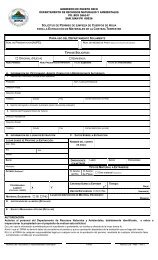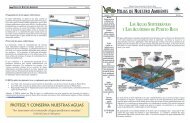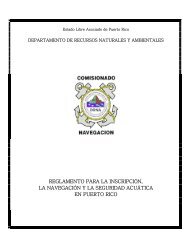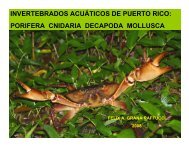Puerto Rico Critical Wildlife Areas - Puerto DRNA - Gobierno de ...
Puerto Rico Critical Wildlife Areas - Puerto DRNA - Gobierno de ...
Puerto Rico Critical Wildlife Areas - Puerto DRNA - Gobierno de ...
Create successful ePaper yourself
Turn your PDF publications into a flip-book with our unique Google optimized e-Paper software.
53- Guánica State Forest and Adjacent Lands, Guayanilla-Yauco-Guánica, <strong>Puerto</strong> <strong>Rico</strong><br />
Area Description:<br />
The Guánica State Forest (GSF) lies in the southwestern part of <strong>Puerto</strong> <strong>Rico</strong>. The area is<br />
classified in the Subtropical Dry Forest Life Zone, a water-limited life zone (Ewel and<br />
Whitmore 1973). The forest and is composed of two portions, which together total about 4,000<br />
ha (Murphy and Lugo, 1990), and inclu<strong>de</strong>s about 500 species of vascular plants in 85 families<br />
(Quevedo et al. 1990). The point of the highest elevation is 228 m above sea level. Guánica Bay<br />
separates the eastern and western parts of the forest. Steep cliffs like rocks guard the entrance to<br />
the Bay. Rainfall is scarce, averaging 25 to 30 inches per year (DNR 1976).<br />
GSF lies in the subtropical dry life zone and it is <strong>de</strong>scribed as one of the best type of this<br />
vegetation in the tropics. Different types of scientific research are conducted in this Forest due<br />
to the presence of high diversity (Silan<strong>de</strong>r et al 1986).<br />
The type of vegetation is varied and inclu<strong>de</strong>s: mangroves; natural salt marsh; beaches;<br />
rocks and cactus; spiny forest; dry forest; evergreen forest; plantations and grass (DRN 1981).<br />
More recently, the DNER prepared a document to propose to the government the extension of<br />
the limits of the forest to inclu<strong>de</strong> Ballena Bay (Bahía Ballena) due to the ecological importance<br />
of the area and to the presence of critical elements of the flora and fauna of <strong>Puerto</strong> <strong>Rico</strong> (<strong>DRNA</strong><br />
1996). The DNER is proposing the extension of the Forest since 1976 in the The Master Plan for<br />
the Commonwealth Forests of <strong>Puerto</strong> <strong>Rico</strong>.<br />
Ownership/Protection:<br />
The GSF is a public land administered by the DNER. The adjacent lands are privately<br />
owned.<br />
Special Recognition:<br />
The area was <strong>de</strong>clared a Forest in 1919. In 1981 was <strong>de</strong>clared as a Biosphere Reserve by<br />
the UNESCO in recognition of its value as one of the best preserved dry forest in the world<br />
(Silan<strong>de</strong>r et al 1986). The GSF is also consi<strong>de</strong>red a Natural Reserve (<strong>DRNA</strong> 1996). Cardona ad<br />
Rivera (1988) inclu<strong>de</strong>d Bahía Ballena as part of the <strong>Puerto</strong> <strong>Rico</strong> <strong>Critical</strong> Coastal <strong>Wildlife</strong> <strong>Areas</strong>.<br />
Bahía Ballena fulfills the requirements to be inclu<strong>de</strong>d in the National Register of places with<br />
archeological values due to the Indian petroglyph find in the place (<strong>DRNA</strong> 1996). In 2004, Bird<br />
Life International and SOPI recognized GSF as an Important Bird Area. The GSF is known to<br />
support the only remaining breeding population of the endangered <strong>Puerto</strong> Rican Crested toad.<br />
Today, the GSF and adjacent land are recognized as a primary wildlife area.<br />
<strong>Wildlife</strong>:<br />
Birds<br />
Forty seven bird species have been reported in GSF: Turkey vulture Cathartes aura,<br />
Red-tailed hawk Buteo jamaicensis, American kestrel Falco sparverius, Zenaida dove Zenaida<br />
aurita, Common ground dove Columbina passerina, Key west quail-dove Geotrygon chrysia,<br />
Ruddy quail-dove G. montana, Mangrove cuckoo Coccyzus minor, Yellow-billed cuckoo C.<br />
americanus, <strong>Puerto</strong> Rican Lizard cuckoo Saurothera vieilloti, Smooth-billed ani Crotophaga<br />
ani, <strong>Puerto</strong> Rican Nightjar Caprimulgus noctitherus, Common nighthawk Chor<strong>de</strong>iles minor,<br />
<strong>Puerto</strong> Rican Emerald Chlorostilbon maugaeus, Antillean Mango Anthracothorax dominicus,<br />
<strong>Puerto</strong> Rican Tody Todus mexicanus, <strong>Puerto</strong> Rican Woodpecker Melanerpes portoricensis,<br />
Gray kingbird Tyrannus dominicensis, Loggerhead kingbird T. caudifasciatus, <strong>Puerto</strong> Rican<br />
Flycatcher Myiarchus antillarum, <strong>Puerto</strong> Rican lesser Antillean Pewee Contopus portoricensis,<br />
210


